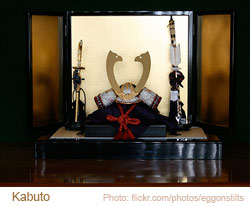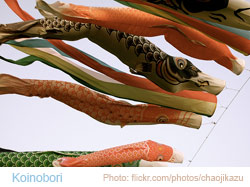Kodomo no Hi is the day when fish are flying and the samurai equipment is out of the closet. It is also a day of traditional sweets or delicious cakes if you prefer that.
Originally, the 5th of May was the day for boys, just as the 3rd of March is Girl’s Day, but now it’s 子供の日(こどものひ – kodomo no hi – Children’s Day). This national holiday 子供の日 (Children’s Day) is also the last day of our longest holiday “ゴールデン・ウィーク (Golden week). At most department stores and bigger supermarkets, big noisy events like “hero show” take place. Not only 子供たち (こどもたち – kodomotachi – children), possibly also 親たち (おやたち – oyatachi – parents) have to participate in the games.
Tasty Cakes and Sweets
Lots of レストラン (resutoran – restaurants) have a special menu for 子供の日 (Children’s Day), and obviously such restaurants are supposed to be wonderfully noisy.
Western style cake shops might sell special decorated cakes for 子供の日, but the traditional sweet for the day is 柏餅 (かしわもち – kashiwa mochi). It’s 餅 (もち – mochi – sticky rice cake) with 餡 (あん – an – sweet bean paste) in it and it’s wrapped with a 柏(かしわ – kashiwa – oak) leaf. Since oak leaves don’t fall until new buds appear, it has the good meaning that the family line will be continued. Personally I like these 和菓子 (わがし – wagashi – Japanese sweets), but little children might prefer ケーキ (keeki – Western type sweets).
Samurai Armor for the Sons
As the 3rd of March is 桃の節句 (momo no sekku), the fifth of May is called 端午の節句 (たんごのせっく – tango no sekku). The word “端午 (tango)” came from an ancient Japanese way of counting days, but now it is only used to refer to the particular day 五月五日 (ごがついつか – gogatsu itsuka – the 5th of May). Namely, “go” from “tango” got meaning “go” (“five”) from the kanji “五” regardless of the original kanji’s meaning. You can see some word play like that. For example, each sekku has a 花 (はな – hana – flower) that symbolizes it, like 桃 (もも – momo – peach) on 3rd of March, and the flower of 端午の節句 (tango no sekku) is 尚武 (しょうぶ – shoubu – iris). This reading “shoubu” connected to another word “勝負 (しょうぶ – shoubu – game/match), and eventually the day was regarded as boy’s day because of that, it seems.
 By the way, apparently the purpose of this custom was originally to prevent things like illness and bad luck. Especially in a samurai’s family, the birth of a boy was very important, so people displayed arms like 兜 (かぶと – kabuto – helmet), 鎧 (よろい – yoroi – armor), 刀 (かたな – katana – sword) and 弓矢 (ゆみや – yumiya – arrows and bow) to guard the boys from the bad things. These were arranged outside the house at first, but later, they were replaced by smaller sized things so that people could put them inside the house.
By the way, apparently the purpose of this custom was originally to prevent things like illness and bad luck. Especially in a samurai’s family, the birth of a boy was very important, so people displayed arms like 兜 (かぶと – kabuto – helmet), 鎧 (よろい – yoroi – armor), 刀 (かたな – katana – sword) and 弓矢 (ゆみや – yumiya – arrows and bow) to guard the boys from the bad things. These were arranged outside the house at first, but later, they were replaced by smaller sized things so that people could put them inside the house.
Well, this was the custom in the upper class world. Common people didn’t have such arms, so they made 兜 (helmet) by 折り紙 (おりがみ – origami – paper folding). It seems. 鯉のぼり (こいのぼり – koinobori – carp streamers) also spread among common people during 江戸時代 (えどじだい – Edo jidai – the Edo period). 鯉のぼり (koinobori) are much more popular than 兜 (helmets) nowadays, but at any rate, both are expensive.
Flying carps!
 Maybe around the middle of April, you can see big 鯉のぼり(koinobori) ”swimming” in the sky above the roof of the house. This fish 鯉 (こい – koi – carp) is made of cloth, and a windy day can make 鯉のぼり (koinobori) quite energic. But actually the number of such 鯉のぼり (koinobori) is decreasing because of the changes in homes. If you have a large space for a pole like a back yard, you can make your 鯉のぼり (koinobori) family swim in the sky pleasantly. But in areas which are crowded with houses and appartments, the big 鯉のぼり (koinobori) may hit other people’s windows. Recently, you can see quite small 鯉のぼり – koinobori) that you place outside your small apartment window. Possibly you might make small paper 鯉のぼり (koinobori) at 小学校 (しょうがっこう – shougakkou – elementary school) or 幼稚園 (ようちえん -youchien – kindergarten), but you have to be careful on rainy days.
Maybe around the middle of April, you can see big 鯉のぼり(koinobori) ”swimming” in the sky above the roof of the house. This fish 鯉 (こい – koi – carp) is made of cloth, and a windy day can make 鯉のぼり (koinobori) quite energic. But actually the number of such 鯉のぼり (koinobori) is decreasing because of the changes in homes. If you have a large space for a pole like a back yard, you can make your 鯉のぼり (koinobori) family swim in the sky pleasantly. But in areas which are crowded with houses and appartments, the big 鯉のぼり (koinobori) may hit other people’s windows. Recently, you can see quite small 鯉のぼり – koinobori) that you place outside your small apartment window. Possibly you might make small paper 鯉のぼり (koinobori) at 小学校 (しょうがっこう – shougakkou – elementary school) or 幼稚園 (ようちえん -youchien – kindergarten), but you have to be careful on rainy days.
Now 子供の日 (Children’s Day) is approaching, and children must be looking forward to something exciting; special TV programs (hero movies or anime, maybe), lunch or dinner at a restaurant, playing at 遊園地 (ゆうえんち – yuuenchi – amusement park), etc etc. Parents, especially fathers, have to spend money or time for the children, so I’m wondering if it’s a real ゴールデン・ウィーク (Golden week) for fathers, lol.
Please tell us about your experiences of Children’s Day, or give us feedback in the bottom of this page.
Vocabulary
Here’s a summary of the vocabulary covered in the article.
- 子供の日 (こどものひ – kodomo no hi – Children’s Day)
- ゴールデン・ウィーク (Golden week)
- 子供たち (こどもたち – kodomotachi – children)
- 親たち (おやたち – oyatachi – parents)
- レストラン (resutoran – restaurants)
- 柏餅 (かしわもち – kashiwa mochi)
- 餅 (もち – mochi – sticky rice cake)
- 餡 (あん – an – sweet bean paste)
- 柏 (かしわ – kashiwa – oak)
- 和菓子 (わがし – wagashi – Japanese sweets)
- ケーキ (keeki – Western type sweets)
- 桃の節句 (momo no sekku)
- 端午の節句 (たんごのせっく – tango no sekku)
- 五月五日 (ごがついつか – gogatsu itsuka – the 5th of May)
- 花 (はな – hana – flower) like 桃 (もも – momo – peach)
- 端午の節句 (tango no sekku) is 尚武 (しょうぶ – shoubu – iris)
- 勝負 (しょうぶ – shoubu – game/match)
- 兜 (かぶと – kabuto – helmet)
- 鎧 (よろい – yoroi – armor)
- 刀 (かたな – katana – sword)
- 弓矢 (ゆみや – yumiya – arrows and bow)
- 折り紙 (おりがみ – origami – paper foldings)
- 鯉のぼり (こいのぼり – koinobori – carp streamers)
- 江戸時代 (えどじだい – Edo jidai – Edo period)
- 鯉 (こい – koi – carp)
- 小学校 (しょうがっこう – shougakkou – elementary school)
- 幼稚園 (ようちえん – youchien – kindergarten)
- 遊園地 (ゆうえんち – yuuenchi – amusement park)